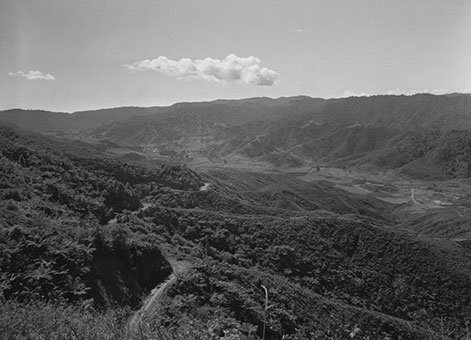Mangatangi Dam, constructed between 1972 and 1977, was the last of a series of rolled earth water supply dams to be completed in Auckland's Hunua Ranges and is one of New Zealand's largest dams. Rolled earth dam design in New Zealand was significantly advanced by the Hunua Ranges dams, constructed between 1950 and 1977.
The construction of the Mangatangi Dam, the first in Stage 2 of the Hunua catchment development, was contingent on completion of a series of aqueduct tunnels built to carry the bulk water from the Mangatangi Valley through to the Moumakai Valley, and then, in combination with water from the Upper Mangatawhiri Dam, through to the Filter Station at Clevedon. The tunnels and the preliminary works for the dam, including at the spillway diversion tunnel and valve tower sites, were completed by the early 1970s, after experiencing several serious delays due to land slip, foundation and excavation difficulties, serious shortcomings in management and planning by the contractor, and difficulties in acquiring experienced labour. These difficulties resulted in a decision to defer the construction of the dam itself in favour of the Wairoa Dam, so that the two would ultimately be advanced concurrently in order to meet the increasing demand for water.

The problem of access between the Moumakai Valley and the Mangatangi Valley dam site was earlier overcome with the surveying of an access road through the bush, mainly by University of Auckland engineering students. By 1973 the problems with the spillway diversion tunnel were overcome, and the river was finally diverted in June 1973, to permit the construction of the dam. In the meantime stripping and preparation of the borrow and haul roads had also been completed.
Dam design and supervision, unlike the other Hunua dams, was undertaken by consultants Tonkin and Taylor, contracted to the Auckland Regional Authority, and incorporated an innovative foundation drainage system using imported greywacke metal (50,000 tonnes) from a farm quarry near Kaiaua. This system was later incorporated into the Wairoa Dam. The dam design incorporated slopes of 2.5:1, with stepped berms following extensive slip circle analysis of the materials.
Mangatangi required 2,140,000 cu.m of fill material making it the third largest dam in New Zealand – “not much less than the Pyramids of Cheops.” Another record set by this project was the bellmouth spillway, which took three years to construct, and at the time was the largest structure of its type in New Zealand. Very efficient fill placing management by the contractor also saw records being broken, 16.5 million cu.m being placed over three working seasons.
Dam details
Crest length: 340 m
Height above foundation:78 m
Dam volume: 2,240,000 cu.m
Catchment area: 3.940 ha
Safe yield: 101,100 cu.m.per day
Reservoir area when full: 169 ha
Storage volume: 39,000,000 cu.m.
More information
Access
The dam is included in Workman Track within the Hunua Ranges Regional Park. Access information is available from the Auckland Council website.
Location
Hunua Ranges Regional Park, Auckland.
